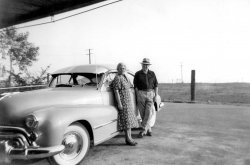
MAY CONTAIN NUTS

Search Shorpy
SHORPY ART

Framed or unframed, desk size to sofa size, printed by us in Arizona and Alabama since 2007. Explore now.
Join and Share
Ad-Free Shorpy
Shorpy is funded by you. Patreon contributors get an ad-free experience.
Learn more.

Recent comments
- Air Quality?
- Sojourner Truth riot
- None were so blind(ed)
- The less famous sister
- Good ol' days?
- Rise and Fall
- Goo Goo Ga Joob
- Ticket Retention
- Not the only one
- Vagaries of War
- Killed by Amtrak
- Back to the Future
- Wanted --
- If you can't stand the light
- Centralized Traffic Control, I believe
- What's really happening
- Heckuva remote control!
- Sometimes — Things Go Bump!
- I SEE THE LIGHT
- Union Switch and Signal Company
- Get That Light Out Of My Eyes
- Eggs. Eggs. Eggs. The Egg Man is Here!
- Foreboding caption
- Famous Hollywood faces
- Not just S&P
- re: Those things in the jar
- Up In Smoke
- Medical Smoking
- Quick fix
- A Quink Comment
Member Photos
The Shorpy
Print Emporium
Print Emporium
Search Shorpy
Search results -- 30 results per page
- Turning Point: 1932
- ... get into the turtle hump box, to wait for that trolley. No car would ever accidentally drive into the turtle hump box, because, as you can ... over 6000 cars.
Ultra rare auto The car with the dealer plates at the right is an extremely rare 1932 DeVaux. One of them was ... Posted by Cazzorla - 05/01/2016 - 2:00pm -
![Turning Point: 1932 Tom Jensen, Los Angeles police officer, chef at the Police Academy and part time actor. I scanned this photo at a family reunion for my mother's 90th birthday. He was my mother's stepmother's brother-in-law's brother. View full size.
A Bag of Nails or an Electric Washing MachineAnd handy for a nice casket right out the door and to the right. Dresslar's was located forever in Downtown Los Angeles at 1130 W. Washington, the spot where this very busy traffic photo was taken.
Mighty Turtle HumpsOkay, the trolley runs down the middle of the street and you have stations to get on it, marked by turtle shell hump dots in the pavement. So you walk across a lane of moving traffic to get into the turtle hump box, to wait for that trolley. No car would ever accidentally drive into the turtle hump box, because, as you can see, those mighty turtle humps are there to tell them not to. And no pedestrian would ever get hit crossing moving traffic, because, as this picture seems to show, even then, Los Angeles traffic was totally jammed.
So, explain to me now, why we don't use mighty turtle hump boxes. They seem to have been so "safe" for all back in 1932.
[They also came handy for cartoon characters, like Porky Pig in Tex Avery's 1937 "Picador Porky." -tterrace]
What hand signal?Not sure just what hand signal the driver at the arrow is making. I thought left hand up was for a left turn, down for a right turn, but that driver's left hand is straight out.
[That's how my father, and other drivers, signaled for a left in California in the 1950s. Arm raised aiming up was for a right and arm down was for slowing. -tterrace]
DeVauxThe pretty sedan in front of Mr Jensen was a rare bird even then, a first-rate salesman named Norman DeVaux brought a new company to market in the spring of '31 and was in receivership before a year was out, total production over two model years was a bit over 6000 cars.
Ultra rare autoThe car with the dealer plates at the right is an extremely rare 1932 DeVaux. One of them was featured in a recent issue of Hemmings Classic Cars. The car immediately behind it is an early '20s Essex built by Hudson.
Pierce-Arrowis the only car I can unequivocally identify with its distinctive fender-mounted headlights looking straight at us from the right rear of the Air Line Transfer truck.
Shorpy's De VauxA 1931 De Vaux with a 65 hp Hall engine can be seen on Shorpy here.
Turtle Humps Cont'dThey are the bane of Shriners everywhere who drive tiny cars in parades. They will flip you if you're not careful.
Next on the list is following mounted units. I'll leave it at that.
In IndianaThat's how we were taught to hand signal in the Hoosier state: Arm up (right turn), arm straight left (left turn), and arm down (slow or stop).
Safety ZoneThose "Turtle Humps" or "Mushrooms" as many call them were used extensively for numerous purposes. Some were lighted, some with reflectors and some with words like STOP. The particular one pictured had LAPD in raised letters on it, one is on display at the LAPD Museum.
I'm getting a headacheIsn't my mother's stepmother's brother-in-law's brother also my mother's stepmother's brother-in-law?
I'm getting a headache.
No Relation?If I understand correctly, this man was the brother of the man who was married to your mother's step-mother's sister.
(ShorpyBlog, Member Gallery)](https://www.shorpy.com/files/images/IMG_0011_1.thumbnail.jpg)
- Caught in Passing: 1920
- San Francisco circa 1920. "Chalmers touring car on Van Ness Avenue." At F.J. Linz Motor Co., your Scripps-Booth dealer. With a streetcar squeezing by. 5x7 glass negative by Christopher ... Posted by Dave - 11/21/2015 - 11:58am -
![Caught in Passing: 1920 San Francisco circa 1920. "Chalmers touring car on Van Ness Avenue." At F.J. Linz Motor Co., your Scripps-Booth dealer. With a streetcar squeezing by. 5x7 glass negative by Christopher Helin. View full size.
Multi makesThis dealer also sold Simplex-Crane cars listed below the Scripts-Booth name and on the second floor is the radiator image and name of the National car. Prices start probably with Scripts-Booth followed by Chalmers, National and Simplex-Crane (a huge expensive car) in that order.
Building on the left The building on the left is still there. The Linz building has been replaced by a hideous square box that is boarded up in the Google Streetview ...
[Though unrecognizable now, it's actually the same building, originally built in 1913 -tterrace]
... but its grand neighbor across Cedar St. is there. It is the Concordia Argonaut Club:
founded in 1864 by Levi Strauss and famous members like Haas, Dinkelspiel, Sutro, Lilienthal, the club was originally composed of only Jewish men, it now admits non-Jews and women. The Concordia-Argonaut Club is one of the premier private clubs in the United States.
Things to Ponder"Is it worth a bent fender to knock that oaf out of the way?"
I know -- the car's not moving or there's a depth of field issue, but it certainly looks as if Mr. Pedestrian is not long to remain in an upright position.
Van Ness - The Auto 'Miracle Mile'In the early 60's Van Ness used to harbor the majority of S.F. auto dealers.
Gotta askBetween the front of the streetcar and the radiator of the automobile we see a rectangle of glass with a Scripps-Booth pennant hanging in the window. The car that we see in the glass is the reflection of our Chalmers touring car, right? And we also see the blurred arm of the man outside on the pavement walking towards the unsmiling driver?
[It's not a reflection. The car is on the street in front of the building. -tterrace]
Well, I'll be. Thanks, tt. Just when I thought I was getting the hang of figuring out photographs.
(The Gallery, Cars, Trucks, Buses, Chris Helin, San Francisco, Streetcars)](https://www.shorpy.com/files/images/SHORPY-779A.thumbnail.jpg)
- Uneasy Rider: 1931
- ... 1931. "Auburn at Golden Gate Park." Similar to the car seen earlier here . 5x7 inch glass negative by Christopher Helin. View ... whites.
Serial Numbers Note that they are both dealer plates. I'd be happy with either car today.
That gentleman needs a ... Posted by Dave - 07/12/2016 - 12:57pm -
![Uneasy Rider: 1931 San Francisco, 1931. "Auburn at Golden Gate Park." Similar to the car seen earlier here. 5x7 inch glass negative by Christopher Helin. View full size.
OffhandedHe should have had the stitches holding his pocket closed removed before he posed for the picture. He would then have been able to get his whole hand into it!
WorrywartThe guy looks a lot like Bob Crosby on a bad day.
Similar, but DifferentThe earlier Auburn is a sedan with a canvas covered roof. This one's a convertible.
[So it is! I thought they had the same tag number, but not quite. -Dave]
Not an easy clean.Imagine crawling underneath That Auburn to scrub those B.F. Goodrich double whites.
Serial NumbersNote that they are both dealer plates. I'd be happy with either car today.
That gentleman needs a shoeshineThen there would be a smile in his heart--even if the scowl on his visage remained the same.
Knockoff HubsWheels, use a hammer to spin the hub cover. If you look carefully, you can see the arrows on the front wheels hubs that indicate which direction they spin. Auburn was quite sporty. This example is interesting in how the height of the windscreen is used to make car look bigger.
HubcapsHow did they get them off. They are only flat on one side to pound them on/ tighten them. You would have to hit on an angle to loosen them.
Auburns looked so great!Like many teens of my generation, I first became aware of Auburns and Cords when Olds introed the Toronado, which hit me (as Nicky-Nick-Nick would say) "Like the hot kiss at the end of a wet fist."
My wife and I are shopping right now for what will likely be our last new car, and they all look like bars of soap.
Re: Knockoff HubsYou used the hammer on the flat side of the 'wings' to loosen the hub (hence, 'knockoff'); the threads on the hub tightened with the rotation of the wheels when the car was moving forward, so the hubs only needed to be hand tightened, with maybe a love tap or two from the hammer. The hammer, incidentally, was wood or leather, to avoid damaging the hubs.
Re: Re: Knockoff HubsBack in the day I owned a 1962 MGA 1600 MkII equipped with wire wheels with knockoff hubs. Rather than wood or leather, the mallet had a solid copper head to avoid damaging the hubs. Wish I had that car today.
HeterogeneityNot readily visible in the photo are the contrasting colors that were in vogue on the 1931 Auburns. The photos below provide much more vivid illustrations of the blatant color schemes available. One of the people assisting the design staff was Count Alexis de Sakhnoffsky who was known for his use of extravagant color schemes. He was, at the same time, also the body designer of the more subtlety colored DeVaux cars seen here.
The Auburn shown is a model 8-98A Custom Phaeton Sedan which cost $1,345 and weighed 3,700 pounds. The freshly styled Auburns were three inches lower than the previous year which was possible by the use of underslung semi-elliptic springs and 17 inch wheels. The bumper with the drop in the center was a covert allusion to the reduced height of all Auburn models. The windshield on this model could fold down over the cowl. Safety glass was optionally available, but radios from the factory were still not offered.
This was Auburn's best year for sales with 32,301 cars produced, and the firm rose from 22nd place in the industry in overall sales to 13th place. It was the only time Auburn broke into the top 20 of U.S. automobile manufacturers. Sales would fall more than 64% in 1932. Auburn production finally ended in August of 1937. The rights, tooling, castings, etc. for the V-12 engine Auburn brought out in 1932 were purchased by American LaFrance, improved, and then utilized in their smaller fire trucks until 1963.
(The Gallery, Cars, Trucks, Buses, Chris Helin, San Francisco)](https://www.shorpy.com/files/images/SHORPY-1005.thumbnail.jpg)
- New Old Stock: 1925
- ... circa 1925. "Montgomery County Motor Co." (the Chevrolet dealer seen here ). National Photo Company glass negative. View full size. ... seen showing how the set would be hooked up to a 6 volt car battery for powering the tube filaments and a high voltage dry battery for ... Posted by Dave - 05/02/2016 - 11:20am -
![New Old Stock: 1925 Rockville, Maryland, circa 1925. "Montgomery County Motor Co." (the Chevrolet dealer seen here). National Photo Company glass negative. View full size.
Parts Dept.This is in the smaller building to the right ("Parts," "Used Cars") in the previous post. The Seiberling All-Treads sign is in the window in both photos.
Atwater Kent RadioThis establishment was probably an Atwater Kent distributor. The company sold its radio products along with ignition parts through automobile outlets during this time. The set is a Model 24 receiver and Model M horn speaker. This is one of the few pictures I have seen showing how the set would be hooked up to a 6 volt car battery for powering the tube filaments and a high voltage dry battery for the plate voltages.
Ceiling constructionAnyone know what that ceiling is? I know drywall wasn't around in 1925 so I'm curious as to what the method was there? Some kind of plaster board perhaps with battens?
Also check out that floor. Concrete tiles?
[Drywall was indeed around in 1925. Used in the construction of many government buildings in and around Washington during World War I. - Dave]
Simplicity itselfJust think how simple it must have been working on those engines! And amazingly many an old Model T got about the same mileage as today's complicated cars.
Up To DateA customer who waits in the chair had the latest Atwater Kent Radio and speaker at his command, if the batteries were up.
Not fussyIt seems to be a Chevrolet dealership that has no problem also selling Ford parts.
Have a SeatI worked for a bearing company in Fresno that started in 1912. We still had the roller bearings (like those pictured), babbit material, and chains for the drives of the old trucks and cars. The old place had what appears to be the same style shelving, too. Would also like to note the nice chair in the right of the photograph. Anyone think it is a Stickley??
More WeathermenSomeone's keeping serious track of the weather, by the look of those atmospheric pressure charts.
Keeping WarmAt left is the ubiquitous potbellied stove, so that staff and customer alike could keep warm while discussing that valve spring or tire patch.
(The Gallery, Cars, Trucks, Buses, Natl Photo)](https://www.shorpy.com/files/images/32219u.thumbnail.jpg)
- Service Man: 1940
- ... machine! Back in my (very small) hometown the Chevy dealer had that same peanut machine sitting on a counter by the front door. It ... under the hood for you, ma'am?"
Any non-serious motor car need you might have is no challenge for this cat and his immediate ... Posted by Dave - 12/27/2019 - 2:34pm -
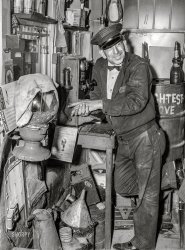
- Elinor Blevins, Auto Fiend: 1915
- ... who apparently went to Lincoln.
Streamliner The car is a racing car (giveaway is the big numbers), but it's also equipped for ... her name! The guy is one D. Braily Gish, a hot-shoe auto dealer in the Washington area known for his fast driving. Who knows if he was ... Posted by Dave - 08/04/2012 - 4:26am -
![Elinor Blevins, Auto Fiend: 1915 Washington, D.C., circa 1915. "Miss Elinor Blevins. Movie star, aviatrix, auto fiend." Harris & Ewing Collection glass negative. View full size.
Movie StarEleanor Blevins from Lincoln, Nebraska, was in 24 movies between 1913 and 1916. This list of Iowa orphans lists an "Elinor Blevins" who apparently went to Lincoln.
StreamlinerThe car is a racing car (giveaway is the big numbers), but it's also equipped for high speeds with special aerodynamic modifications. Note the fairing around the radiator in front and the boat tail. It might be that the exhaust coming out of the dashboard, as noted by Toto, is some sort of aero trick of the period, since it would be tough on the passenger. It would be piping hot after a few minutes with engine running, and if it leaked, it would gas both the occupants with carbon monoxide (cars of the period usually ran rich, and of course had no catalytic converters).
I do not see any third person in the car even though I blew up the picture. To me it looks like the car is right hand drive and Miss Blevins is driving, even though the male passenger has goggles (appropriate for the period with no windshield) and she doesn't. The cockpits of racing cars of the period would hardly have room for a third person anyway.
Could it be that the car was prepared for a land speed record attempt? That would explain the fairing. Could it be British? That might explain the right hand drive.
[There were plenty of RHD American cars in the teens. No one would be gassed by CO -- it's an open car. That "hidden driver" comment -- it was a joke. Next! - Dave]
Hidden DriverI can't be the only one to notice that she isn't driving the car. There are three occupants. The man in the near passenger seat, she is in the middle, and the driver is clearly a slouched-down Oscar the Grouch. You can see his hand on the steering wheel.
ExhaustedCould that possibly be the exhaust pipe coming out of the passenger compartment beneath the man's arm? If not what is it?
They're definitely sittingThey're definitely sitting still, as the cameras of that period didn't have fast enough shutters to capture motion effectively. Not a pedal car, though. You can see the engine crank on the front between the wheels.
[Shutter speeds on a good circa 1915 camera -- measured in thousandths of a second -- would indeed be fast enough to freeze the wheels on a moving vehicle. The question would be how fast can the car be going before the wheels start to blur. - Dave]
Whoah, Nellie!"Movie star, aviatrix, auto fiend?" I think I have a new girl-crush!
Weightman SpecialWell at long last I know her name! The guy is one D. Braily Gish, a hot-shoe auto dealer in the Washington area known for his fast driving. Who knows if he was related to the famous actress sisters. The racing car is called the Weightman Special and still exists. It was made up by an eccentric millionaire named William "Wild Bill" Weightman, the ne'er-do-well heir of a Philadelphia dynasty known for its monopoly on the production of quinine. "Will Bill" fancied himself a race car driver and bought up or built several such cars. This one was made on the frame of a Stutz Bearcat and had a most unusual racing engine -- hence the exhaust pipe exiting through the cockpit.
The pictures were probably part of a set taken by the National Photo Company in Washington during November of 1916, when auto races were held at the Benning Track, a horse racing oval east of the city. D. Braily Gish won the feature race in the Weightman Special against other local speed demons. The car was then sent to California, where "Wild Bill" Weightman raced it. It survives in a private collection.
And here it is todayAt Monterey.
(The Gallery, Cars, Trucks, Buses, D.C., Harris + Ewing, Movies)](https://www.shorpy.com/files/images/08141a.thumbnail.jpg)
- Pike's Peak Champion: 1920
- 1920 or 1921. "Lexington. Pike's Peak car." One of two Lexington racecars that placed first and second in the 1920 ... Peak climb. The drivers were Otto Loesche (1st place in car #7) and Albert M Cline (2nd in car # 6). Perhaps this is the #7 car without ... about 34 mph climbing Pike's Peak. The Washington dealer of Lexington autos was located at 1020 Connecticut Avenue, N.W., perhaps ... Posted by Dave - 08/05/2012 - 10:56am -
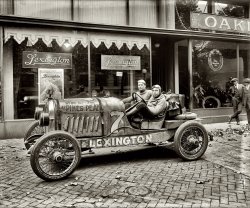
- East From Majestic: 1903
- ... the dealership of William E. Metzger - the pioneering auto dealer. In 1903, his luck was about to peak. After 1908, he shifted from ... of this picture would help to found the Cadillac Motor Car Co., which was the first of many such automotive ventures that Mr. Metzger ... Posted by Dave - 07/20/2012 - 7:17pm -
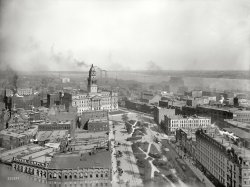
- Texaco Tanker: 1925
- ...
Texaco truck Just remember, you can trust your car, to the man who wears the star.......
Chain Drive Macks The old ... noisy at speed.I grew up in New England and the local coal dealer had a couple of these old chain drive Macks. You could tell they were ... Posted by Dave - 09/03/2012 - 10:44am -
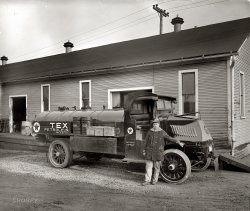
- Doctor of Tires: 1934
- ... Helin. View full size.
Very Frustrating The car appears to be a 1931 Studebaker of some sort, but I can't pin down the ... customization of the era? Or a customization at all? Dealer badge? Seems like that would have been pretty darn expensive at the ... Posted by Dave - 12/07/2014 - 5:11pm -
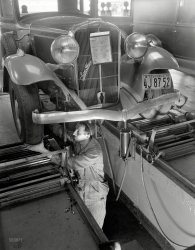
- G Street: 1925
- ... Typothetae of Washington, Huff Duplicating and an Ediphone dealer. National Photo Co. glass negative. View full size.
Driving around with no spare The car in front of the cafeteria. A Moon sedan, as identified by Hayslip. And I'm ... Posted by Dave - 11/27/2013 - 12:18pm -
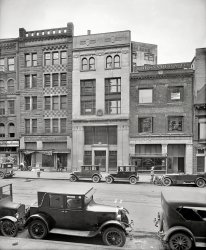
- Eldorado: 1955
- ... View full size.
Mighty Steel Now, that's a Car!
Differences In 1955 the Eldorado only came as a convertible ... and Biarritz extra-cost options listed in the 1956 dealer literature include air conditioning, remote trunk lid release, tinted ... Posted by Dave - 11/01/2012 - 5:08pm -
![Eldorado: 1955 A 1956 Cadillac Eldorado Seville photographed in 1955. From a series of 8x10 glossies with an ink stamp on the back reading "Styling Department, Ford Motor Company, Dearborn Mich." Keeping an eye on the competition. View full size.
Mighty SteelNow, that's a Car!
DifferencesIn 1955 the Eldorado only came as a convertible (Cadillac called it a Sport Convertible Coupe), and there were just two options: a power seat for $54 and air conditioning for $620. The list price was $6,286 and 3,950 were built. The engine was rated at 270 horsepower.
In 1956 the Eldorado came as both a two door hardtop (Seville) and a convertible (Biarritz). There were no options available on either model other than an upgraded engine - 305 horsepower instead of 285. List price was $6,501 for either model. There were 3,900 coupes and 2,150 convertibles built.
Although very similar, even from the back differences can be seen: different bumpers, the shape of the exhaust pipe exits, the nameplate and trim above the trunk lock, and trim on the lower trunk disappearing.
[Air-conditioning was not available for convertibles in the 1955 Cadillac line, including the Eldorado; the only options listed for the "Eldorado Special Convertible" are tinted glass, Autronic Eye headlight dimmer and spotlight. A four-way power seat was standard. Eldorado Seville and Biarritz extra-cost options listed in the 1956 dealer literature include air conditioning, remote trunk lid release, tinted glass and Autronic Eye. The 305-hp engine was standard. Optional at no additional cost were a gold-anodized grille and wheels. - Dave]
Take Me to Your LeaderI remember a "Boys' Life" magazine issue from the 1950's where a close up picture of the these tail lights and the bumper exhaust port won a photo contest with the caption: "Take Me to Your Leader". The 1950's were great years for auto fin and tail light madness. Hollywood also started looking to space for its movie monsters.
Eldorado FanI always liked the copper color with the accent interior.
We're Excited!Dave, Could you tell us the "color" of the Car before all the excitement begins?
[8-bit grayscale. - Dave]
DroolingI.want.that.car!!! That would be great to tool around in.
Eldorado fanAt around the same time, the 9-year-old me, also enamored of the rear end of the Eldorado, was talking my brother into taking this shot of a 1955 model. Much later, it became one of my earliest Shorpy submissions.
Oh Boy!Does this mean we get to see the rest of the series? I can't wait!
[Set your dials for EXCITEMENT! -Dave]
Comparative PricingInteresting to see the list prices for the '55 Caddy and to realize that for an additional $3500 or so you could have bought a '55 Mercedes-Benz Gullwing coupe. Both cars have appreciated in the years since.
Nice and coolThe intake scoops on either side of the trunk tells me that it has air conditioning (the unit with the evaporator and its *two* blowers is mounted in the trunk, below the parcel shelf). And it also has Autronic Eye (the sensor is on the dash on the driver's side).
(The Gallery, Cars, Trucks, Buses, Detroit Photos)](https://www.shorpy.com/files/images/SHORPY_1956_Cadillac_Eldorado_Seville.thumbnail.jpg)
- Tri-Five Drive-In: 1957
- March 1957. Gary, Indiana. "Teenage girls in car at drive-in." From photos for the Look magazine assignment "How American ... below the wing window—which, depending on how the dealer installed accessory was mounted, could prevent the window from opening ... Posted by Dave - 05/06/2019 - 12:59pm -
![Tri-Five Drive-In: 1957 March 1957. Gary, Indiana. "Teenage girls in car at drive-in." From photos for the Look magazine assignment "How American Teenagers Live." View full size.
Handy hardtopThe absence of a B pillar enables more people to get into the shot. No doubt that's what the designers had in mind as well.
It's refreshing to see kids looking up while having fun rather than staring at their smart phones, isn't it?
Great MemoriesFor these young ladies. Also the girl in the glasses looks like my wife when she was that age.
Since I am from a country that is not acclimatized to drive-ins, my wife took me to one years ago here in Dayton. I could see why these girls look happy.
'56 Chevrolet Bel-AirAll you need is the trim to identify the model--Pontiac used the same body. I think it was Alfred P. Sloan (he of "a car for every purse and purpose") who also recognized the importance of small visual cues to differentiate models--Buick's port holes, Olds's rocket, Cadillac's fishtail lights.
Drinks in bottlesI remember well when you got a real soda to drink and not a paper cup with 70% ice, carbonated water with a splash of syrup. Dad's Root Beer, Pepsi and ( anyone known #3 ?
Chances AreThe girls are listening to Elvis, Buddy Holly, the Everly Brothers et al on the old AM. And some guy named Mathis had a hit that year too I believe.
'56 Chevy, yes, but --Not necessarily a Bel-Air. The 210 also came in a hardtop and its chrome started in just the same way.
[The '55 also had similar trim. - Dave]
MemoriesThat takes me back to those wonderful days of my youth when it was all good.
GirlfriendsNice to see Imogene Coca and Patty Duke together.
The PerkettesThese girls have had entirely too much sugar.
The Age is in the DetailsThe upper paint divider (that chrome and black strip indicated by the blue arrow in the photo below) that runs on a slant from the beltline dip to the chrome spear reveals this to be a 1955 Sport Coupe. If there was another half-inch to the bottom of the main photo, we could see if there was a chrome spear running from the front fender to the middle of the door. Bel Airs had the front spear, while the 210s did not. As it is, there may be just a hint of a shadow under the Shorpy logo to suggest that the spear is there.
The teenager's car appears to have a remote control rear view mirror on the driver's side. These were mounted ahead of the wing window. As seen in the photo below, the regular outside rear view mirror was mounted just below the wing window—which, depending on how the dealer installed accessory was mounted, could prevent the window from opening all the way.
1955 Bel AirThe car is a 1955 Chevrolet Bel Air sport coupe. The hash marks on the diagonal paint divider are unique to that year. Also on the 1956 the door lock is closer to the door handle.
[Both years had hash marks; in 1956 they were separated by strakes. - Dave]
Where are they now?If these six happy girls were high school seniors in 1957, they would be about 77 or 78 today. Wouldn't it be fun to re-photograph them in a similar photo now? I graduated h.s. in that same year and I can assure you that this was a very familiar sight from coast to coast and everywhere in between. Our drive-in hot spot was "The Big Dip" on old route 8 in Beacon Falls, Ct. Always lots of action every night of the week, hit tunes from the era and memories that have never faded. This pic definitely brought me priceless and wonderful flashbacks.
(Cars, Trucks, Buses, LOOK)](https://www.shorpy.com/files/images/SHORPY-10619u.thumbnail.jpg)
- The 1960 Look
- ... "stick-on, bits and bobs",found all over the "dee-luks" dealer add ons these days.
More Polestar The 1960 Dodge Matador also ... improvements. VW was fond of such an approach. Same car as last year with 58 changes was a typical VW style advert.
Description ... Posted by Dave - 07/01/2016 - 2:46pm -
![The 1960 Look July 1959. "Detroit's 1960 look. Sneak preview of the new models." This particular example being a Dodge Polara convertible minus some ornamentation. 35mm color transparency for Look magazine. View full size.
When chrome was chrome!Mmmmmm....real factory chrome. Not the "stick-on, bits and bobs",found all over the "dee-luks" dealer add ons these days.
More PolestarThe 1960 Dodge Matador also used the polestar trim in the same location, but there wasn't a Matador convertible. The Matador was a one year only model that filled the price gap between the lower priced Dart and the top of the line Polara. Almost 28,000 were produced among four different models (2 sedans, a coupe, and a station wagon). A Matador coupe is below.
ChangeKeyword for American Auto Design during this period. Always new and fresh. When showroom windows would be covered with paper during the late fall when next years models were due. And most foreign cars would carry on with no major exterior changes, but often, lots of small internal improvements. VW was fond of such an approach. Same car as last year with 58 changes was a typical VW style advert.
Description CorrectionThis 1960 Dodge Polara displays the complete correct standard trim for its model. There was OPTIONAL lower body trim that included what car guys generally call a wide bright stainless "washboard" behind the rear wheel well but again, that was an option. Great color photo. Glad you posted it.
["Correction" correction: It's missing the fin ornament. You can see the four holes where it's supposed to go. - Dave]
FinsNot people from Finland either.
I guess the space race had a lot to do with this look!
I miss those days.As a teenager in the 50's, riding our bikes to the local dealers to check out the new models. Sneaking to the rear of the dealers lot to see the yearly changes, never disappointed.
In-house previewI worked at Chrysler Canada as a tradesman in the 1960s and got a first hand preview of the new models as we were doing plant "changeovers".
I couldn't tell you what was coming or I'd have to kill you.
Correction correctionI know my eyesight is becoming more unreliable, but for the life of me I cannot see the screw holes where the missing tail fin is to be attached.
[There is no "missing tailfin." The tailfin is missing an ornament -- a stylized compass rose pointing way to the car's namesake of Polaris, the North Star. Another aspect of the contemporary fad for all things Arctic after Alaska's admission to the Union in 1959. - Dave]
Those were the daysBack when you could identify a car as it passed you on the street.
(The Gallery, Kodachromes, Cars, Trucks, Buses, LOOK)](https://www.shorpy.com/files/images/SHORPY-09869u1.thumbnail.jpg)
- Home Office: 1956
- ... Dallas. Bedroom to adjoining office." Our third look at car dealer Earl Hayes' contemporary cottage. Photo by Maynard L. Parker for House ... Posted by Dave - 03/03/2015 - 9:42pm -
![Home Office: 1956 1956. "Hayes residence, Kessler Lake Drive, Dallas. Bedroom to adjoining office." Our third look at car dealer Earl Hayes' contemporary cottage. Photo by Maynard L. Parker for House Beautiful. Source: Huntington Library. View full size.
Chaise Lounge ChairIs what that piece of furniture in the immediate right foreground is called. It's too long to be a real chair, but too short to be a real chaise lounge--kind of a compromise between the two that looks like it would be pretty awkward to use in real life--and of course it comes standard equipped with the spindly legs of the era.
[Ahem. Chaise LONGUE ("shez lonzh"). French for "long chair." Over the years misspelled and mispronounced by us dyslexic Amercuns into the bastardized and redundant "chaise lounge chair." - Dave]
Another great interiorOne half expects to see Laura Petrie in capri pants perched on the edge of the desk.
Wool carpetsAs a carpet cleaner in a former life, I recognize that broadloom carpeting as being made of wool. They are super soft and nice to walk on but they do wear pretty badly in traffic areas ( halls and around beds etc. ) Cleaning them is a real delight if it's your first time! The water makes them all stretchy and out of shape until they dry and go back to the way they were. Had to calm down a few customers during those jobs!
Contemporary CoolCentral air conditioning in houses was just getting good around 1956, which must have been a welcome relief in steamy Dallas, especially after a day peddling black DeSotos.
Come out our way, trade your wayHere's a short article on the history of Earl Hayes Chevrolet Co., located at 9th and Lancaster in Oak Cliff. Earl later brought his son Robert into the business, and it became Bob Hayes Chevrolet.
A well-equipped home office for its day.Note the multi-line keyed telephone and the intercom system on the credenza. That is a far higher level of equipage than would be seen in a typical home office in that day. Makes me wonder if he had leased lines to his dealership facility.
The settee and the two chairs peeking up beyond the credenza give a sense that the furnishings of this office were chosen to accommodate business visitors. The keyed mortise lock on the three-section sliding door reinforces this.
Can anyone discern any of the titles in his home library? There's an obvious "U.S. News and World Report" in the magazine rack.
[And a Business Week. -tterrace]
Neatness countsLike anyone else, I admire neatness, but where do these people keep all their "stuff"? Where is all their mail, newspapers, ads, munchies, dog bed, cat toys, pet treats, house shoes, M & M's, afghan/throw cover, writing implements, phone gadgets, checkbook, shopping lists and the myriad of other necessary stuff that seems to junk up my house? Maybe I really am a hopeless slob.
[They put it all away until the photographer leaves. -tterrace]
Every Room Looks the SameHow could they even tell where they were? Did they carry maps with them?
BroadloomI’m not loving the wall-to-wall carpeting in these shots. Close up, it looks like scorched earth or the beach. It’s the kind that was fine after vacuuming until someone walked on it.
Isle of CapriClose-up detail of the Hayes office - and there's Laura Petrie near the desk, ready to take your dictation.
(Maynard L. Parker, The Office)](https://www.shorpy.com/files/images/SHORPY-office.thumbnail.jpg)
- Witt-Will: 1915
- ... W.W. Griffith, who is well known as a large coal and ice dealer, is president of the company. William F. Legg, the vice president and ... factory manager and head designer for the St. Louis Motor Car Company; superintendent for the E.R. Thomas Motor Company, and factory ... Posted by Dave - 07/12/2019 - 12:11pm -
![Witt-Will: 1915 Washington, D.C., circa 1915. "Witt-Will motor truck plant, 52 N Street N.E." National Photo Company Collection glass negative. View full size.
aaaa-UUUUUU-ggaaaaa!!Looks like a considerable horn mounted there just aft the driver's seat. Electric? Air-powered? Is that a little lever on top for the driver to pump?
Witt-WillWitt-Will trucks were manufactured in Washington, D.C., at 52 N Street N.E., "in the shadow of the White House." The company was an outgrowth of the W.W. Griffith Company, which started as an automobile manufacturer in 1911. In March 1914 Griffith founded the Witt-Will Truck Company, which folded in 1933.
Photobucket has a few photos of Witt-Will coal trucks.
[One of them taken from Shorpy! - Dave]
Giving Good Service
Washington Post, Apr 5, 1914
Making Trucks Here
Witt-Will Company Takes Over Business
Started by W.W. Griffith.
The newly formed Witt-Will company, with large facilities for building motor trucks and maintaining motor-truck service, is the outgrowth of the automobile truck manufacturing business begun here by W.W. Griffith in 1911. The company has taken over the manufacturing plant at 52 N street northeast, and is proceeding on a schedule which calls for five completed motor trucks each month. The company is maintaining a service department and a complete repair shop, together with a body building and paint shop.
The Witt-Will trucks are designed for 1-ton capacity and upward, many heavy trucks being in commission at the present time and giving good service. W.W. Griffith, who is well known as a large coal and ice dealer, is president of the company. William F. Legg, the vice president and factory manager of the company, is a Cornell graduate in mechanical engineering, and has been successively head designer for the Thomas B. Jeffery Company; factory manager and head designer for the St. Louis Motor Car Company; superintendent for the E.R. Thomas Motor Company, and factory manager and head designer for the Carter Motor Car Corporation.
John L. Bowles, who is the secretary and auditor for the company, has had a long business career, and for the past year has been an auditor for Mr. Griffith's motor truck building business. John M. Dugan has resigned as superintendent of the Washington office of the Bradstreet company to accept the position of treasurer and sales manager of the Witt-Will company.
B StreetI'm struck by the truck for G.M. Woolf's "Agricultural Implements and Seeds" located at 1005 B St. NW. I believe the Department of Justice now stands there, on the street long since renamed Constitution Avenue.
Chain driveThe truck in the background has a chain drive on the rear wheels. I didn't know that chain drives were used on road vehicles, I have only seen them used on heavy equipment (tractors, etc.) of the era.
[Many if not most early automobiles and trucks used chain or belt drives. - Dave]
(The Gallery, Cars, Trucks, Buses, D.C., Gas Stations, Natl Photo)](https://www.shorpy.com/files/images/30739u.thumbnail.jpg)
- Treasury Truck: 1925
- ... graduated to the manufacture of truck bodies for passenger car chassis and were offering their own line of trucks by 1920. Their success ... and drive trains, for sale exclusively through the Dodge dealer network.--
Source - AACA Museum
Rag top commercial truck? ... Posted by Dave - 09/12/2013 - 7:23pm -
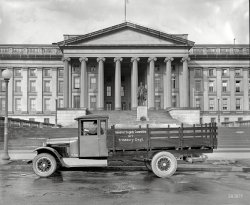
- Minker Motor Co.: 1922
- ... fitting suit, but at least a decent shine. Wouldn't a car salesman taken a little more care in his appearance?
Blue Collar ... up; however, it would have been fairly easy for a Columbia dealer to replace damaged originals.
The front and rear tires are are of ... Posted by Dave - 08/07/2012 - 10:41pm -
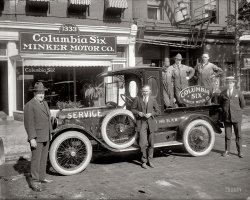
- Hudson, Peerless, Pope: 1910
- ... above a Hudson center stage at the showroom of J.H. Brady, dealer in Hudson, Peerless and Pope-Hartford automobiles. 8x10 inch dry plate ... Detroit Publishing Company. View full size.
A Car Is Born That's a 1909 Hudson Model 20 Roadster under the gas light, the ... Posted by Dave - 07/04/2011 - 2:09pm -
![Hudson, Peerless, Pope: 1910 Detroit, Michigan, circa 1910. "Brady -- Gas Company. Auto showroom." Star billing goes to the gas light fixtures above a Hudson center stage at the showroom of J.H. Brady, dealer in Hudson, Peerless and Pope-Hartford automobiles. 8x10 inch dry plate glass negative, Detroit Publishing Company. View full size.
A Car Is BornThat's a 1909 Hudson Model 20 Roadster under the gas light, the Hudson Motor Car Company's first offering. It was a sturdy and reliable car and began the company's 45 years as an independent automaker.
The HudsonSomeone tell me how someone other than the Houston Rockets' Yao Ming could drive this thing.
Landaulets and RoadstersJohn H. Brady was president of this company, which according to the 1911 Detroit City Directory was the "Michigan distributors for Peerless, Pope, Hartford and Hudson Automobiles." The Directory also indicates that "Cobb Brothers Auto Repairs" was located in the rear of that same address, which was at the southwest corner of Jefferson Ave. and Beaubien St. Today the Renaissance Center and General Motors World Headquarters occupy this site.
Whoa!Got kind of a funhouse mirror effect.
1910s cars and tobacco juiceEvery time I see a picture of a car from the 1910s with a back seat, I think of a story my grandmother told. During the 1920s, her family got a car that was about ten years old, and had the open sides, like some in this picture. She and her sister and brother fought over who had to sit behind their dad. He chewed tobacco and would spit out his side of the car. Of course, whoever was sitting behind him was in danger of getting tobacco juice in the face! I can't think of much that would be worse to get a face full of!
Self PortraitThe photographer, camera and flash.
Those Are Gaslights?I never saw a gaslight before with the globes pointing down instead of up. Also it seems odd they'd have gaslights in the showroom when there is obviously electric light in the next room, complete with cords along the ceiling and a nifty housing for the one light nearest the showroom that looks like it was made from a tin can. Whatever they are though, they're beautiful!
[Those are gaslights. Each chandelier has a pair of pulls to regulate flow. Below is another example from Detroit City Gas Co. - Dave]
(The Gallery, Cars, Trucks, Buses, Detroit Photos, DPC)](https://www.shorpy.com/files/images/4a26690a.thumbnail.jpg)
- Hop In: 1919
- ... you not talk to the guy who's actually working on your car.
Big Sign Shop Zooming in we see the name of the business that made ...
Buying a car? This reminds me of the last time a dealer sold me a car. He insisted that the car he was selling me is a demo and ... Posted by Dave - 07/08/2011 - 5:58pm -
![Hop In: 1919 Washington, D.C., circa 1919. "Washington Battery Co., L Street." We saw the garage earlier in this post. National Photo Co. glass negative. View full size.
Before the Insurance ExcuseThey asked politely that you not talk to the guy who's actually working on your car.
Big Sign ShopZooming in we see the name of the business that made the sign. Like it.
Pick Me UpIs this the ancestor of all pickup trucks?
Also: note the sign. No talking to the mechanics.
Hard Four Years CrankingSuper is offering a lift in his 1915 Ford Model T Runabout. No starter motors on this model. He hand cranks it and then gets in.
Rear deck and bulb type horn have been replaced with aftermarket pickup bed and manual horn. Practical pickup style not offered by Ford until 1925.
The BIG SIGN SHOP, Inc.On my best day I couldn't photograph something like this and get the clarity that it shown in this photo.
Brought to mindThis vehicle reminded me of the plastic model car kits my brother and I used to put together in the late forties, very early fifties during long summer days with no school. They were usually (very) antique old-time cars which we could not conceive of being road-worthy, which we had never seen and which we usually messed up due to the plastic cement which dissolved the plastic and the enamel paint which was difficult to apply neatly. Also each and every little part had to be attached, sometimes with a heated metal object to secure wheels, spokes, etc. The kits were sold in dime stores for a dollar or less. Just for the halibut, I decided a minute ago to look them up on the interweb. There are no more $1 car models, more like $20 and up, and the ones we had are long gone. I first heard about Stanley Steamers and Model T Fords via those plastic do-it-yourself car models. Remember plastic bubbles and magic growing rocks? All kinds of cheap crap to keep the kids busy in the summer. Good times.
Such a spindly little thingIt's the scrawny 98 pound weakling of pickup trucks, compared to the 2-ton behemoths of today.
Pick Em Up TruckI can't get past the sign with the words "any information desired will be cheerfully given". As if you would expect to get info delivered in a grouchy manner.
Buying a car?This reminds me of the last time a dealer sold me a car. He insisted that the car he was selling me is a demo and nothing was wrong with it. After having problems with the car he sold me I went to his workmen and asked them for a computer printout and sure enough the car was in a major accident! "We Respectfully request costumers to refrain from talking to workmen any information desired will be cheerfully given by floor superintendent."
[That Bob Mackie was kind of a blabbermouth. - Dave]
Highway PioneersMy first modeling experience was building some of the styrene Highway Pioneers models made by Revell. I built a bunch of them and had a lot of fun in the process. They were not terribly durable, at least in my young hands, but I loved them nevertheless. The distinctive feature that I remember, like OTY describes, was the way the wheels were attached. You were supposed to heat a slot screwdriver tip over a flame, and use it to melt the end of the axle. This formed a tip at the end like a nailhead that kept the wheel on. It was clever, by you had to be careful not to melt the axle into the wheel. No two hubs ever looked quite the same, but it worked.
(The Gallery, Cars, Trucks, Buses, D.C., Natl Photo)](https://www.shorpy.com/files/images/30828u.thumbnail.jpg)
- Five & Dime: 1939
- ... the Farm Security Administration. View full size.
Car ID Chevrolet coupe with landau irons circa 1928. Gas filler on the left; ... I was in that building last year. It now houses a flooring dealer, but I could still see some of the original walls and ceiling and could ... Posted by Dave - 08/22/2014 - 10:00am -
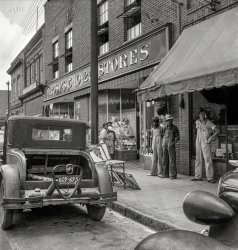
- Lanza Motors: 1920
- ... Motors Co., exterior, 14th Street." Lanza Motors sold a car called the Metz; neither would be long for this world -- a world whose ... look as good. And where is the actual showroom for the dealer?
[Behind the doors. - Dave]
We'll Save Money On The ... Posted by Dave - 01/25/2012 - 11:55am -
![Lanza Motors: 1920 Washington, D.C., circa 1920. "Lanza Motors Co., exterior, 14th Street." Lanza Motors sold a car called the Metz; neither would be long for this world -- a world whose sidewalks were trod by ectoplasmic pedestrians. View full size.
Metz Master 6Great photos thank you Dave for sending the information to http://www.metzauto.wordpress.com We have shared it with our members.
Also here is a Google Street View of the site today. The Frank D. Reeves Center for Municipal Affairs is located on the site now.
View Larger Map
Forget the Metz...I'd love to see the inside of the La Pricesse corset shop!
Metz Friction DriveThe earlier models of the Metz car used a unique continuously variable ratio transmission. It had a rubber-tired wheel that ran perpendicular to a huge machined flywheel on the motor. The driver operated a lever that changed the location of the driven wheel on the flywheel. When the driven wheel was dead center on the flywheel, that was neutral. As the driven wheel moved away from center in one direction an infinite number of forward ratios could be achieved. When the driven wheel moved away from center in the opposite direction an infinite number of reverse ratios could be achieved!
While Metz Drive died in passenger car use, it was used on garden tractors for many years (and still may be). This clever transmission was limited in its ability to handle loads. It also had durability issues.
Very modern bay windowThe window showing off the brass beds is quite modern looking; too bad the Metz didn't look as good. And where is the actual showroom for the dealer?
[Behind the doors. - Dave]
We'll Save Money On The Rent!An automobile showroom that's too small to hold even one floor model seems to have been a mistake. Unless the Metz 6 could really drive through those front doors.
[The Lanza Motors showroom (below) held at least five cars. - Dave]
BoardwalkAnyone know what the boardwalk in the street is for?
[It's a streetcar boarding platform. - Dave]
Metz Master Six
Washington Post, Feb 1, 1920.
TO HANDLE METZ.
Lanza Motor Co. Opens Salesroom
On Fourteenth Street.
The Lanza Motors Company has opened a salesroom at 2008 Fourteenth street northwest for the sale of the Metz motor cars. The Metz is one of the oldest cars on the market, but up to this year they have built [only] a friction drive car.
This year's model is a six-cylinder model with the standard type of transmission and gear shift. The car is built in four models, a five-passenger touring, three-passenger roadster, two-passenger coupe and five-passenger sedan.
Ghostly MotionIf you look very closely, on front of the buffet and the corset shop, there are apparently disembodied feet on the sidewalk. I'd be interested to know how long the exposure was, for the people to be almost entirely invisible.
[These are the "ectoplasmic pedestrians" mentioned in the caption. Exposure time would be around one or two seconds. - Dave]
(The Gallery, Cars, Trucks, Buses, D.C., Natl Photo, Streetcars)](https://www.shorpy.com/files/images/28660u.thumbnail.jpg)
- Kiwi Garage: 1908
- ... manufacturer. This garage may be the establishment of a dealer, and at this period, most dealerships were tiny affairs, often one man retailing one car at a time, or handling various brands as he saw fit. It is nice to see the ... Posted by Dave - 08/23/2013 - 7:43pm -
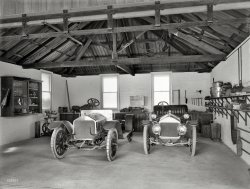
- Safety Stutz: 1927
- ... Plymouth The last time I checked a few weeks ago, my car still had its 4 wheel hydraulic brakes, just as it (and all other 50,000 ... selling feature touted in their magazine advertising and dealer brochures.
1929 Plymouth My Dad bought me a 1929 Plymouth to ... Posted by Dave - 07/21/2020 - 1:02pm -
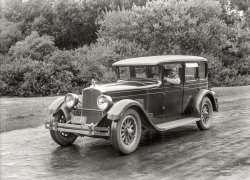
- Bumper to Bumper: 1941
- ... fella, I got a hot date!" I'd actually assume this is a dealer or distributor lot. Can't be a downtown parking lot!
[It is ... where you have to wait till the end of the day to get your car. - Dave]
Been there, waited for that As late as the early-70s (and ... Posted by Dave - 09/20/2020 - 1:03pm -
![Bumper to Bumper: 1941 July 1941. "Parking lot. Chicago, Illinois." This is what you call being in a tight spot! 35mm nitrate negative by John Vachon for the Farm Security Administration. View full size.
Why no older models?There are usually some from the early '30s in the mix, but the oldest cars here seem to be from 1936 or so. Someone who knows more about antique autos than I do will be along shortly to educate me, and that's OK, too.
[After around 1935, when cars began to be made with steel roofs and all-steel bodies, the number of older vehicles in these photos drops off sharply. - Dave]
Do believe it is a normal parking lotThese cars seem to have come from some transport or are waiting to go on one, a ship or maybe a train since they look like they are all the same manufacturer. You can see photos like it of arriving Japanese verhicles that came off a ship.
["The same manufacturer"? I see a Pontiac, a Plymouth, an Oldsmobile ... - Dave]
The one in the middle!"Yeah, here's my tag - it's the two tone coupe, the one in the middle. And make it snappy, fella, I got a hot date!" I'd actually assume this is a dealer or distributor lot. Can't be a downtown parking lot!
[It is downtown, one of several such scenes photographed by John Vachon. Note that the cars have license plates, a smattering of windshield stickers, and various parcels visible through their windows, some of which are open. I would imagine this is the kind of lot where you have to wait till the end of the day to get your car. - Dave]
Been there, waited for thatAs late as the early-70s (and maybe beyond) there were large parking lots at Memorial Stadium in Baltimore that packed cars in just like that. You had better have been prepared to stay for the whole game because unless you were lucky there was no way out 'till it was over.
Fake ViewsDear Dave,
Something's wrong with this picture. All these cars are like, really old.
Not even that black Dodgein dead center trapped between a Chevrolet and Pontiac could ram its way out of that crowded lot!
The old saying when backing up"Keep going till you hear the crash" must have been employed here.
As for older vehicles, I'm fairly sure that of the 40 or so in the parking lot at work, my 2008 Ford pickup is the oldest.
The root of the term "bumper"It seems to me from images such as these, and old movies, that bumpers were once meant to be literally bumped. What happened?
(The Gallery, Cars, Trucks, Buses, Chicago, John Vachon)](https://www.shorpy.com/files/images/SHORPY-8a32781a.thumbnail.jpg)
- Tops and Trimmings: 1921
- ... prizes in the horse show rings of those days.
As a dealer he furnished many horses for the diplomatic set. He later entered the ... The company started out in 1914 as the Alter Motor Car Company in Plymouth, Michigan. Some websites claim that it is linked to ... Posted by Dave - 08/07/2012 - 3:07am -
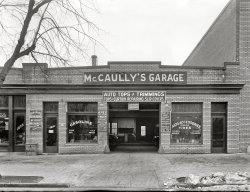
- Dodge for Dummies: 1948
- ...
UFO It looks like a spaceship is about to beam the car and dummy up into its hold.
Our family car A 1948 Dodge was our ... that Woody Wagon!
Worth a Continental Too bad this dealer didn't handle Lincoln rather than Dodge-Plymouth, as the building's ... Posted by Dave - 03/06/2013 - 12:03pm -
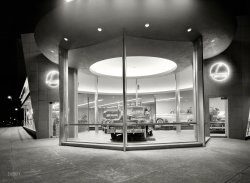
- Mom, Uncle John, the Porsche and Me
- ... it has alloy wheels". These were readily available as a dealer option on the 912)
Classic This is a classic photo. Your dad framed it perfectly, the car and the people are in a natural pose, your mother is beautiful and your ... Posted by AmericanJarhead - 09/20/2011 - 10:18pm -
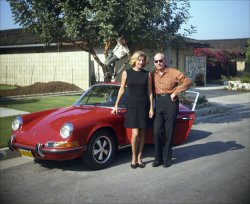
- Running Behind: 1963
- ...
1963 Back then you could actually fix your own car.
Fancy Taxi This was a top of the line 1956 Plymouth Belvedere ... had a 1957 Plymouth back in the day. After a visit to the dealer to replace the light bulb behind the buttons, it seems the panel was not ... Posted by Dave - 07/18/2015 - 8:24pm -
![Running Behind: 1963 1963. "Cab driver and taxi at Saxony Bar & Lounge, Boston." 35mm negative, photographer unknown. Another eBay find scanned by Shorpy. View full size.
What's He Going For?Based on his near-full immersion, the gearshift linkage or the starter motor.
Poor man's power steering"Necker's knob" on the steering wheel.
1963Back then you could actually fix your own car.
Fancy TaxiThis was a top of the line 1956 Plymouth Belvedere before it became a cab. It even has the optional wire wheel hubcaps. Most taxi companies used a specially equipped stripped down Savoy model with a six cylinder engine.
A Cheap Bike Lockseems to have found a better use as a hood tie-down on this battered Belvedere.
[It's a hood lock now. - Dave]
My dad the cab driver.My dad drove a cab in Boston from 1962 to 1964 so you can imagine that this caught my eye. He was tall and slender so I don't think this is him. Unfortunately he passed away a year ago but oh boy....he would have LOVED this photo. Thanks.
Stick or AutomaticIf it's a stick I would guess he's trying to get the shift levers back in alignment.
Those old "three on the tree" shifters could get worn and jump in between the levers, leaving you stuck in one gear.
[With no shift lever to be seen here, the car had a PowerFlite automatic transmission controlled by pushbuttons on the dash. - Dave]
Park SquareThe Saxony Lounge was located in Park Square, which for many years was the location of the Greyhound/Trailways bus depot and home to a lot of sketchy activity (drug use, prostitution, street theft, you name it). More recent arrivals to Boston will know Park Square as it currently exists - the home of upscale restaurants, office buildings, and fancy hotels - it has undergone a massive transformation in the past 20 years. I don't think either the buildings or the street shown in this photo still exist. (The address of the Saxony was 35 Providence St. - although there is still a street with that name it's really no more than an alley. I think this portion of it was in an area that got reconfigured.)
That darned pushbutton PowerFliteWe had a 1957 Plymouth back in the day. After a visit to the dealer to replace the light bulb behind the buttons, it seems the panel was not properly secured. One good bump on the way home and - off comes the panel, and out pop the buttons? After a couple of tries, I figured which went where and off we went.
Havana-Where one would now need to go to see such a nice variety of late 1950s American autos in everyday urban service.
(The Gallery, Boston, Cars, Trucks, Buses, Found Photos)](https://www.shorpy.com/files/images/SHORPY-BW-009.thumbnail.jpg)
- Hog of the Road: 1949
- ... Chryslers in 1972. Kelly Motors, the local Sonora Olds dealer used to insist on placing big bumper stickers that had two green shamrocks and said "Buy Kelly Cars." on each car they serviced. As clever as that motto is, my uncle insisted on the service ... Posted by bunaen - 11/02/2012 - 7:50pm -
